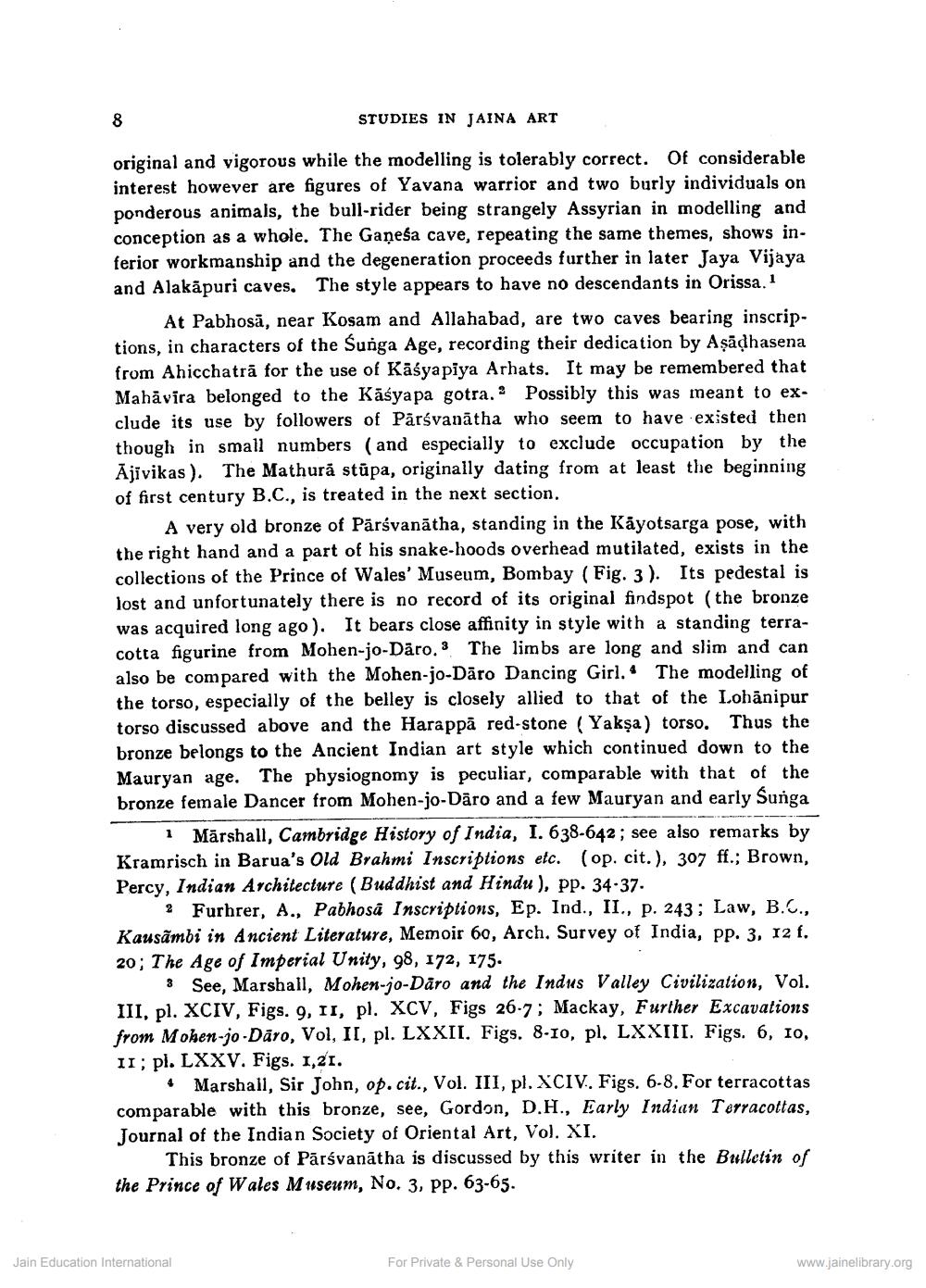________________
8
STUDIES IN JAINA ART
original and vigorous while the modelling is tolerably correct. Of considerable interest however are figures of Yavana warrior and two burly individuals on ponderous animals, the bull-rider being strangely Assyrian in modelling and conception as a whole. The Ganesa cave, repeating the same themes, shows inferior workmanship and the degeneration proceeds further in later Jaya Vijaya and Alakāpuri caves. The style appears to have no descendants in Orissa.1
At Pabhosa, near Kosam and Allahabad, are two caves bearing inscriptions, in characters of the Sunga Age, recording their dedication by Aşădhasena from Ahicchatra for the use of Kasyaplya Arhats. It may be remembered that Mahavira belonged to the Kasyapa gotra. Possibly this was meant to exclude its use by followers of Parsvanatha who seem to have existed then though in small numbers (and especially to exclude occupation by the Ajivikas). The Mathura stupa, originally dating from at least the beginning of first century B.C., is treated in the next section.
A very old bronze of Pärśvanatha, standing in the Kayotsarga pose, with the right hand and a part of his snake-hoods overhead mutilated, exists in the collections of the Prince of Wales' Museum, Bombay (Fig. 3). Its pedestal is lost and unfortunately there is no record of its original findspot (the bronze was acquired long ago). It bears close affinity in style with a standing terracotta figurine from Mohen-jo-Daro. The limbs are long and slim and can also be compared with the Mohen-jo-Daro Dancing Girl. The modelling of the torso, especially of the belley is closely allied to that of the Lohanipur torso discussed above and the Harappa red-stone (Yakşa) torso. Thus the bronze belongs to the Ancient Indian art style which continued down to the Mauryan age. The physiognomy is peculiar, comparable with that of the bronze female Dancer from Mohen-jo-Dāro and a few Mauryan and early Sunga
1 Marshall, Cambridge History of India, I. 638-642; see also remarks by Kramrisch in Barua's Old Brahmi Inscriptions etc. (op. cit.), 307 ff.; Brown, Percy, Indian Architecture (Buddhist and Hindu), pp. 34-37.
Furhrer, A., Pabhosa Inscriptions, Ep. Ind., II., p. 243; Law, B.C., Kausambi in Ancient Literature, Memoir 60, Arch. Survey of India, pp. 3, 121. 20; The Age of Imperial Unity, 98, 172, 175.
See, Marshall, Mohen-jo-Daro and the Indus Valley Civilization, Vol. III, pl. XCIV, Figs. 9, II, pl. XCV, Figs 26-7; Mackay, Further Excavations from Mohenjo Daro, Vol. II, pl. LXXII. Figs. 8-10, pl. LXXIII. Figs. 6, 10, 11; pl. LXXV. Figs. 1,21.
4 Marshall, Sir John, op. cit., Vol. III, pl. XCIV. Figs. 6-8. For terracottas comparable with this bronze, see, Gordon, D.H., Early Indian Terracottas, Journal of the Indian Society of Oriental Art, Vol. XI.
This bronze of Pārśvanatha is discussed by this writer in the Bulletin of the Prince of Wales Museum, No. 3, pp. 63-65.
Jain Education International
For Private & Personal Use Only
www.jainelibrary.org




